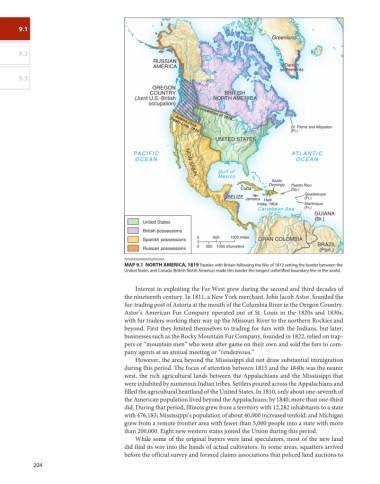Page 237 - American Stories, A History of the United States
P. 237
9.1
Greenland
9.2
RUSSIAN
AMERICA Danish
settlements
9.3
OREGON
COUNTRY BRITISH
(Joint U.S.-British NORTH AMERICA
occupation) Convention of 1818
Adams-Onís
St. Pierre and Miquelon
(Fr.)
Treaty Line, 1819
UNITED STATES
PACIFIC AT LANTIC
OCEAN NEW SPAIN OCEAN
Gulf of
Mexico
Santo
Domingo Puerto Rico
Cuba (Sp.)
Guadeloupe
BELIZE (Fr.)
Jamaica Haiti
Indep. 1804 Martinique
Caribbean Sea (Fr.)
GUIANA
(Br.)
United States
British possessions
0 500 1000 miles
Spanish possessions GRAN COLOMBIA
BRAZIL
0 500 1000 kilometers
Russian possessions (Port.)
MaP 9.1 noRth aMERica, 1819 Treaties with britain following the War of 1812 setting the border between the
United States and canada (british North America) made this border the longest unfortified boundary line in the world.
Interest in exploiting the Far West grew during the second and third decades of
the nineteenth century. In 1811, a New York merchant, John Jacob Astor, founded the
fur-trading post of Astoria at the mouth of the Columbia River in the Oregon Country.
Astor’s American Fur Company operated out of St. Louis in the 1820s and 1830s,
with fur traders working their way up the Missouri River to the northern Rockies and
beyond. First they limited themselves to trading for furs with the Indians, but later,
businesses such as the Rocky Mountain Fur Company, founded in 1822, relied on trap-
pers or “mountain men” who went after game on their own and sold the furs to com-
pany agents at an annual meeting or “rendezvous.”
However, the area beyond the Mississippi did not draw substantial immigration
during this period. The focus of attention between 1815 and the 1840s was the nearer
west, the rich agricultural lands between the Appalachians and the Mississippi that
were inhabited by numerous Indian tribes. Settlers poured across the Appalachians and
filled the agricultural heartland of the United States. In 1810, only about one-seventh of
the American population lived beyond the Appalachians; by 1840, more than one-third
did. During that period, Illinois grew from a territory with 12,282 inhabitants to a state
with 476,183; Mississippi’s population of about 40,000 increased tenfold; and Michigan
grew from a remote frontier area with fewer than 5,000 people into a state with more
than 200,000. Eight new western states joined the Union during this period.
While some of the original buyers were land speculators, most of the new land
did find its way into the hands of actual cultivators. In some areas, squatters arrived
before the official survey and formed claims associations that policed land auctions to
204

